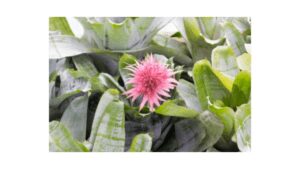Introduction
The common varieties of Urn plants are Aechmea rhodocyanea (A. fasciata) and A. fulgens belong to the family Bromeliaceae. the former plant is having grey-green foliage with a fist-sized bract having dotted tiny pink flowers. The following article is about the care of urn plant.
Main varieties of Urn plant
- A. rhodocyanea – Also known as A. fasciata. Is the common variety with grey-green foliage. The colour of the bract is pink with tiny blue flowers. This plants ornamental look is mainly due to the colourful bract which remains as it is up to six months.
- A. fulgens – Relatively smaller than the above. With open rosette with a green upper surface and red underneath having a purple colour flower.
Origin
The Urn plants are, mainly originated from South America and are known for their beautiful bract and durability. The unique urn-shaped structure of this plant makes it efficient to survive during drought. The recurving and overlapping leaves of this plants helps in storing the rainwater and other nutrients in the form of dead insects and other debris which is the main provider of nutrient and water for many months during the drought season.
Besides this, the plant is highly valued for its beautiful bright vivid coloured bract. The bract during the flowering season produces bright tiny flowers and gives it a glowing appearance.
How to propagate Urn plant

The urn plant is commercially propagated through seeds. But if you want to multiply the plant in your house it will be much better to propagate via offshoots. As offshoots are a much better and easy way of propagation and also give true to type plant. Remove the offshoot from the base of the plant and pot this in a loose mixture of peat and perlite.
It is advisable to buy those urn plants which is showing young bract. These plants are quite expensive because it requires nearly 5-6 years to reach the flowering stage.
How to take care of Urn plant
Following physical conditions should be looked after for the take care of urn plant
Light condition
Needs indirect sunlight. as partial sunlight helps the leaf to become more dark and bright. This plant is a very hardy plant and can be good as an indoor plant.
Watering
It needs a moist and humid environment. Water only when the topsoil becomes dry. As this plant has the capacity to store water in the rosette therefore water in the central rosette when the leaves become 2.5 cm or more. Change the water every two or three weeks.
Soil conditions
Use an open mixture with the free drainage system. Peat based composed with an equal part of peat and little sphagnum moss will be good for its growth and development. Repotting every one year is advisable.
Temperature
Moderate to warm 15-21 degrees Celcius is good for this plant. Avoid extreme hot and extremely cold temperatures.
Pests and insects
Older bracts may be attacked by Mealybugs. Clean or remove the bugs with a small soft toothbrush dipped in methylated spirit.
